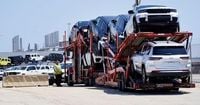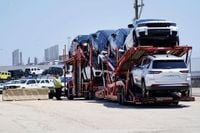Stellantis, the world’s fourth-largest carmaker, found itself at the center of a dramatic market swing on October 30, 2025, as its shares tumbled 10% following the release of its third-quarter financial results. Despite posting a 13% increase in net revenues to 37.2 billion euros ($43.2 billion) for the three months ending in September, the company’s warning about potential future charges rattled investors and cast a shadow over what otherwise looked like a promising turnaround. The slide saw Stellantis shares close at 8.74 euros ($10.16) on the Milan Stock Exchange, underscoring the market’s sensitivity to even modest uncertainty in the auto sector, according to the Associated Press.
This latest chapter marks a sharp turn in fortunes for Stellantis, which had endured seven consecutive quarters of decline before this recent uptick. The company, a product of the 2021 merger between French automaker PSA Peugeot and Italian-U.S. giant Fiat Chrysler Automobiles, is best known for brands like Jeep, Fiat, and Peugeot. Under the new leadership of CEO Antonio Filosa, who took the helm in June 2025, Stellantis has sought to inject new energy into its operations and product lineup, particularly in North America.
“As we continue to implement important strategic changes in order to provide our customers with greater freedom of choice, we have seen positive sequential progress and solid year-over-year performance in Q3, marked by the return of top-line growth,” Filosa said in a statement, as reported by the Associated Press. His optimism is not unfounded: shipments rose 13% to 1.3 million vehicles in the third quarter, with North America accounting for nearly 70% of the 152,000 new vehicles shipped. The resurgence was powered by the relaunch of fan favorites like the HEMI V-8-powered RAM 1500, a model previously discontinued but brought back to meet U.S. demand.
Stellantis’ U.S. sales grew 6% in the period, pushing its market share to 8.7%—a 15-month high. Globally, vehicle sales rose 4%, with notable gains in Europe, the Middle East, and Africa. In Europe, net revenues climbed 4%, although market share dipped to 15.4% due to softer conditions in France and Italy. It’s a mixed bag, but one that shows at least tentative signs of momentum.
Still, the celebration was muted by Stellantis’ warning about possible future charges in the second half of 2025. The company pointed to regulatory changes and an ongoing review of its warranty estimation process as potential sources of additional costs. While no specific figures were provided, the caution was enough to trigger a sharp sell-off in the stock, highlighting investor anxiety about the unpredictable nature of global automotive regulations and the costs of compliance.
Beyond the financials, Stellantis has been busy on the product and strategy front. Over the first nine months of 2025, the company launched six new models, with plans to introduce four more before the year’s end. The aggressive rollout is part of Filosa’s broader effort to reenergize the company after what he described as “dismal” results in 2024—results that ultimately led to the ouster of former CEO Carlos Tavares. Filosa’s strategy also includes relaunching vehicles that previous management had discontinued, aiming to better align the company’s offerings with U.S. consumer preferences.
Strategic management changes have accompanied the product push. Filosa recently appointed Emanuele Cappellano as head of Europe and European brands, a move intended to sharpen Stellantis’ focus in a region where competition remains fierce and consumer tastes are rapidly evolving. A new business plan is expected to be unveiled in 2026, signaling that more changes could be on the horizon.
Stellantis’ legal and fiscal home is in the Netherlands, but its operational footprint is global—and growing. Earlier in October, the company announced a $13 billion investment plan for the United States over the next four years. The initiative aims to expand Stellantis’ manufacturing capabilities, boost vehicle production by 50%, and create 5,000 jobs. The move is seen as a strategic buffer against U.S. President Donald Trump’s tariffs, which have posed a significant cost challenge for automakers with international supply chains.
The cost of these tariffs is not trivial. Stellantis recently updated its estimate for the impact of U.S. tariffs in 2025, lowering it to 1 billion euros ($1.16 billion) from a previous projection of 1.5 billion euros ($1.7 billion). The company’s ability to manage these external pressures while investing in growth will be closely watched by analysts and investors alike.
Looking at the bigger picture, Stellantis’ journey since its creation in 2021 has been anything but smooth. The merger of PSA Peugeot and Fiat Chrysler Automobiles was hailed as a bold move to create a global powerhouse capable of competing with the likes of Toyota, Volkswagen, and General Motors. Yet, the integration process has been fraught with challenges, from aligning corporate cultures to rationalizing overlapping product lines and navigating the increasingly complex regulatory environment in key markets.
Filosa’s tenure represents a clear break from the past. He has moved quickly to address what he saw as missteps by previous management, particularly the decision to discontinue popular models in the U.S. market. By reversing course and bringing back vehicles like the RAM 1500, Stellantis hopes to recapture market share and rebuild its reputation among American consumers. The company’s renewed focus on the U.S.—both in terms of product offerings and manufacturing investments—reflects the enduring importance of the North American market to its global ambitions.
Meanwhile, Stellantis’ performance in Europe remains a work in progress. While net revenues are up, the dip in market share in France and Italy signals ongoing challenges. The appointment of Cappellano and the promise of a new business plan suggest that further adjustments are on the way. The company’s ability to balance growth in North America with stability in Europe will be critical as it seeks to solidify its position on the global stage.
For now, investors are taking a wait-and-see approach. The market’s reaction to the third-quarter results and the warning about future charges underscores the high stakes facing Stellantis as it navigates a rapidly changing industry landscape. With electric vehicles, regulatory pressures, and shifting consumer preferences all in play, the road ahead is anything but certain.
Yet, as Filosa’s statement suggests, there is cautious optimism inside Stellantis’ executive suite. The company has ended its losing streak, posted solid growth in key markets, and laid out ambitious plans for the future. Whether this marks the start of a sustained turnaround or just a brief respite remains to be seen. But one thing is clear: Stellantis is back in the game, and the auto world will be watching closely as the next chapter unfolds.

